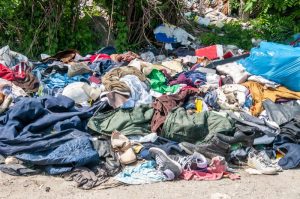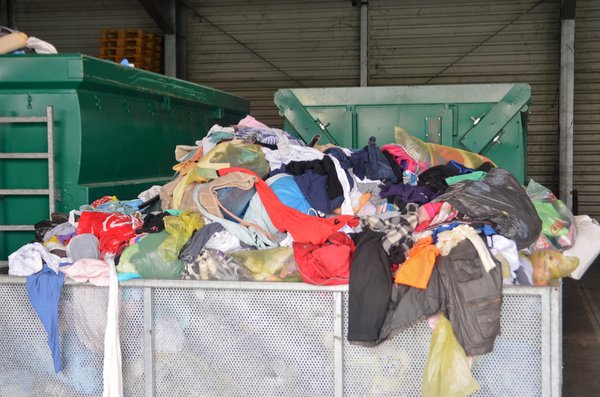As the world becomes more aware about how we impact the environment around us, we pay closer attention to what we throw away or the impact of what we are purchasing. The average environmentally conscious consumer is making informed decisions about the brands and stores they choose to support. In some cases, people dedicate themselves to zero waste lifestyles which is now possible in urban centres thanks to stores dedicated to this philosophy. So what does this mean for the clothing and fashion industries?
Fast fashion brands such as Zara and H&M have come under scrutiny as their business models of pumping out clothing at an unprecedented rate has pushed the fashion industry into the second biggest producer of greenhouse emissions, second to only to oil (not to mention the labour concerns as well). If you consider that crude oil is needed to produce synthetic fabrics such as polyester, the most common material used in fast fashion, it keeps adding up. The fashion industry contributes 20% of global water waste. accounting for 20%. On top of that, the fact that 85% of clothes discarded end up in a landfill, the industry needs to adapt to earn the trust of the consumer.
But the consumer needs to improve too, especially in North America where consumerism is at it’s strongest and over a third of the fashion economy takes place. Across the board people are wearing their clothes less until they feel the need to replace them, often throwing out items with a simple tear rather than taking the time to repair it, allowing wasteful business practices to become very profitable.
Sustainable fashion is a quickly growing movement, especially with thrift shops and vintage stores becoming more and more popular.
 These stores satisfy the desire for something unique in a saturated market at an affordable price. But fashion sustainability has a long way to go. Only 1% of textiles produced for clothing get recycled. Organizations such as the UN have taken measures to address the fashion industry’s waste by encouraging a circular economy and taking measures to improve the quality of life for marginalized factory workers. Taking this into account along with the social trend of sustainability, credential clothing and textile recycling industries can only stand to grow.
These stores satisfy the desire for something unique in a saturated market at an affordable price. But fashion sustainability has a long way to go. Only 1% of textiles produced for clothing get recycled. Organizations such as the UN have taken measures to address the fashion industry’s waste by encouraging a circular economy and taking measures to improve the quality of life for marginalized factory workers. Taking this into account along with the social trend of sustainability, credential clothing and textile recycling industries can only stand to grow.
How does credential clothing help reduce fashion waste?

Credential clothing refers to unwanted clothes bagged and dropped into donation boxes. These are picked up and bundled in the same condition they were donated. These unsorted clothes are highly sought after by fashion resellers as they often can contain rare vintage items, designer clothes or other items such as shoes or hats. In most cases, and unsurprisingly, these items are found to still be in great quality. Credential clothing dealers, such as us at Bank and Vogue, keeps these unwanted clothes in circulation, avoiding landfill destinations or the practice of burning unsold clothes to save money on the costs of recycling.
At Bank and Vogue, we have committed to doing our part for solving this “crisis of stuff” problem as we call it. We were founded to follow our passion and beliefs, creating opportunities for our sellers and customers while building a great family-based business to find solutions for this crisis of stuff. By combining our knowledge and experience we aim to play a meaningful role in contributing to a closed loop economy in clothing and textiles. We buy and sell credential clothing for thrift and vintage stores, ensuring they have the quality product to keep their business going. We cannot reach our goals alone!
What is next for Credential Clothing?
With the fashion industry operating with so much waste today, credential clothing will continue to play a big role in promoting the circular economy of clothing. Credential clothing offers a benefit to store owners for an affordable stock of unique, quality clothing items that would have ended up in a landfill otherwise. Customers gain the benefit of a constant stream of new affordable, recycled clothing options in stores, the same benefit of fast fashion brands without the environmental impact. And there is enough of it to go around.

At Bank and Vogue we exclusively deal with bulk orders, with loose items being sold at a minimum of 25,000 pounds, while baled clothing starts at 40,000 pounds. We operate a successful chain of vintage and used clothing stores in Europe and manage thrift stores across the U.S. so we know it can be daunting to build a business in the used clothing market. We can help build your business through our retail and process management consulting to keep your store running smoothly and logistics services to keep it supplies without the stress. While the mission is to facilitate increase recycling efforts, for the credential clothing market to be successful, businesses should stay in tune to trends and season while leveraging modern technology and networking to help you drive success. Let’s tackle the crisis of stuff and do our part in protecting the environment together!
To learn more about how we can help you with the “crisis of stuff” and achieving sustainability for both your business and the environment, contact us at 1-866-613-0719 (North America) or 1-613-747-8465 (International).







